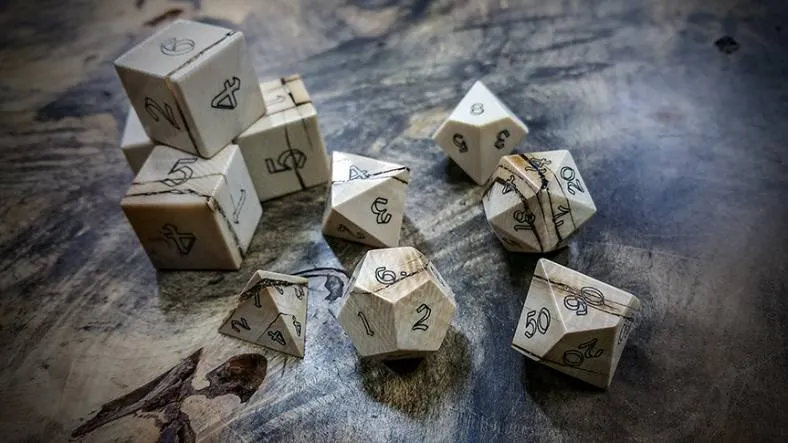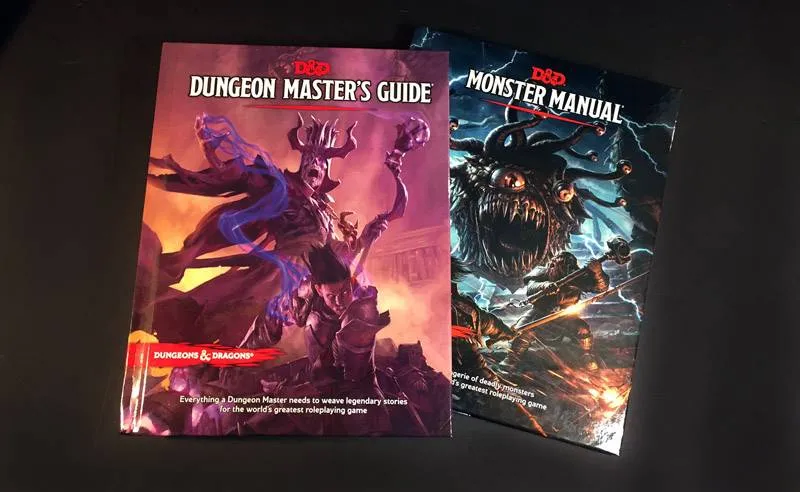
The Books You Need to Play Dungeons and Dragons
This content contains affiliate links. When you buy through these links, we may earn an affiliate commission.
If you’ve never played Dungeons and Dragons (D&D) before, it might surprise you to note that books play an essential role (unless you read this article). While those polyhedral dice (especially your D20) are necessary, it’s awfully hard to play without knowing the rules, getting some guidance, or using a module. So for all you intrepid D&D noobs out there, here are the books you need to play D&D.
 Essential: The Player’s Handbook. If nothing else, you need to consult The Player’s Handbook. Within the Handbook, you’ll find everything you need to play from basic rules (What’s initiative? How do you kill something? What are ability scores?) to creating your character (What extras does a halfling grant you? What’s the best race if you want to be a barbarian? What are the different types of humans, elves, and dwarves?) to spells (What’s the difference between druid, bard, and warlock spells? How do you cast Charm Person? How much damage does Magic Missiles do?). There are even neat little asides from D&D-based novels and tidbits about the multiverse. While it’s possible to have another player explain the rules to you or to get a pre-made character from the Internet, D&D will always remain somewhat inscrutable if you don’t at least glance through the Handbook. Believe me, I know.
Recommended: The Monster Manual and The Dungeon Master’s Guide. If all you want to do is play Dungeons and Dragons, not Dungeon Master (DM) or submerse yourself into the culture, the Handbook is good enough. However, if you’re hoping to make your own world or guide your own group of stalwart adventures through certain doom, you really should pick up The Monster Manual and The Dungeon Master’s Guide. The Monster Manual gives you stats on dozens of different monsters, telling you how hard they are to kill (the challenge rating), what kind of damage they can do (under melee and ranged attacks), and what special skills they have (such as blindvision or resistance to certain types of damage). Paging through this can tell you about all the amazing monsters, beasts, and aberrations in the multiverse and is necessary if you want to structure a game. The Dungeon Master’s Guide is a bit fluffier, but it does give you dozens of cool magic items to enhance your play, helps you calculate how characters live and work in the world, and gives you the framework to either understand the world or create your own. It’s best used after you’ve already read The Player’s Handbook.
Essential: The Player’s Handbook. If nothing else, you need to consult The Player’s Handbook. Within the Handbook, you’ll find everything you need to play from basic rules (What’s initiative? How do you kill something? What are ability scores?) to creating your character (What extras does a halfling grant you? What’s the best race if you want to be a barbarian? What are the different types of humans, elves, and dwarves?) to spells (What’s the difference between druid, bard, and warlock spells? How do you cast Charm Person? How much damage does Magic Missiles do?). There are even neat little asides from D&D-based novels and tidbits about the multiverse. While it’s possible to have another player explain the rules to you or to get a pre-made character from the Internet, D&D will always remain somewhat inscrutable if you don’t at least glance through the Handbook. Believe me, I know.
Recommended: The Monster Manual and The Dungeon Master’s Guide. If all you want to do is play Dungeons and Dragons, not Dungeon Master (DM) or submerse yourself into the culture, the Handbook is good enough. However, if you’re hoping to make your own world or guide your own group of stalwart adventures through certain doom, you really should pick up The Monster Manual and The Dungeon Master’s Guide. The Monster Manual gives you stats on dozens of different monsters, telling you how hard they are to kill (the challenge rating), what kind of damage they can do (under melee and ranged attacks), and what special skills they have (such as blindvision or resistance to certain types of damage). Paging through this can tell you about all the amazing monsters, beasts, and aberrations in the multiverse and is necessary if you want to structure a game. The Dungeon Master’s Guide is a bit fluffier, but it does give you dozens of cool magic items to enhance your play, helps you calculate how characters live and work in the world, and gives you the framework to either understand the world or create your own. It’s best used after you’ve already read The Player’s Handbook.

 Essential: The Player’s Handbook. If nothing else, you need to consult The Player’s Handbook. Within the Handbook, you’ll find everything you need to play from basic rules (What’s initiative? How do you kill something? What are ability scores?) to creating your character (What extras does a halfling grant you? What’s the best race if you want to be a barbarian? What are the different types of humans, elves, and dwarves?) to spells (What’s the difference between druid, bard, and warlock spells? How do you cast Charm Person? How much damage does Magic Missiles do?). There are even neat little asides from D&D-based novels and tidbits about the multiverse. While it’s possible to have another player explain the rules to you or to get a pre-made character from the Internet, D&D will always remain somewhat inscrutable if you don’t at least glance through the Handbook. Believe me, I know.
Recommended: The Monster Manual and The Dungeon Master’s Guide. If all you want to do is play Dungeons and Dragons, not Dungeon Master (DM) or submerse yourself into the culture, the Handbook is good enough. However, if you’re hoping to make your own world or guide your own group of stalwart adventures through certain doom, you really should pick up The Monster Manual and The Dungeon Master’s Guide. The Monster Manual gives you stats on dozens of different monsters, telling you how hard they are to kill (the challenge rating), what kind of damage they can do (under melee and ranged attacks), and what special skills they have (such as blindvision or resistance to certain types of damage). Paging through this can tell you about all the amazing monsters, beasts, and aberrations in the multiverse and is necessary if you want to structure a game. The Dungeon Master’s Guide is a bit fluffier, but it does give you dozens of cool magic items to enhance your play, helps you calculate how characters live and work in the world, and gives you the framework to either understand the world or create your own. It’s best used after you’ve already read The Player’s Handbook.
Essential: The Player’s Handbook. If nothing else, you need to consult The Player’s Handbook. Within the Handbook, you’ll find everything you need to play from basic rules (What’s initiative? How do you kill something? What are ability scores?) to creating your character (What extras does a halfling grant you? What’s the best race if you want to be a barbarian? What are the different types of humans, elves, and dwarves?) to spells (What’s the difference between druid, bard, and warlock spells? How do you cast Charm Person? How much damage does Magic Missiles do?). There are even neat little asides from D&D-based novels and tidbits about the multiverse. While it’s possible to have another player explain the rules to you or to get a pre-made character from the Internet, D&D will always remain somewhat inscrutable if you don’t at least glance through the Handbook. Believe me, I know.
Recommended: The Monster Manual and The Dungeon Master’s Guide. If all you want to do is play Dungeons and Dragons, not Dungeon Master (DM) or submerse yourself into the culture, the Handbook is good enough. However, if you’re hoping to make your own world or guide your own group of stalwart adventures through certain doom, you really should pick up The Monster Manual and The Dungeon Master’s Guide. The Monster Manual gives you stats on dozens of different monsters, telling you how hard they are to kill (the challenge rating), what kind of damage they can do (under melee and ranged attacks), and what special skills they have (such as blindvision or resistance to certain types of damage). Paging through this can tell you about all the amazing monsters, beasts, and aberrations in the multiverse and is necessary if you want to structure a game. The Dungeon Master’s Guide is a bit fluffier, but it does give you dozens of cool magic items to enhance your play, helps you calculate how characters live and work in the world, and gives you the framework to either understand the world or create your own. It’s best used after you’ve already read The Player’s Handbook.

My personal favorite is The Monster Manual. Go look up a flumph. It’s adorable.
Nice to have: Modules. A module in D&D is essentially a pre-made campaign (or “story”) that you can either play or run/DM. It will have “adventure hooks,” which your characters can choose to take as well as maps of various areas, villains to fight, NPCs (non-player characters) to role play, and more. There are dozens of different modules to play, and they correspond with the different editions (versions of the game that are tweaked and released every few years). Right now, the newest version of D&D is 5th edition (5e), and the modules for that are The Lost Mines of Phandelver (the Starter Set), The Curse of Strahd, The Storm King’s Thunder, The Princes of the Apocalypse, Out of the Abyss, Tales from the Yawning Portal, Hoard of the Dragon Queen, and The Rise of Tiamat (with more coming soon!). Each module offers the players different worlds, different monsters, and different opportunities to be a hero (or villain. You do you.). The best way to figure out which one you want to play is by paging through them or listening to a stream of people playing it.
I’m currently DMing this one, and it is EPIC. Just look at that bird lady!
Extraneous: Guides and companion books. For hard core fans or people really interested in the nitty-gritty and often unknown details of the multiverse, there are also guides and companion books. So far, you can choose from Volo’s Guide to Monsters, Xanathar’s Guide to Everything, Dungeonology, and Sword Coast Adventurer’s Guide – plus some specialty books about different lairs, monsters, campaigns, etc. (There are a LOT of resources out there.). Each of these books offers something new such as new monsters to fighter and learn about, better ways to craft a dungeon crawl, and new races to play. None of these are essential reading, but they are pretty cool.




